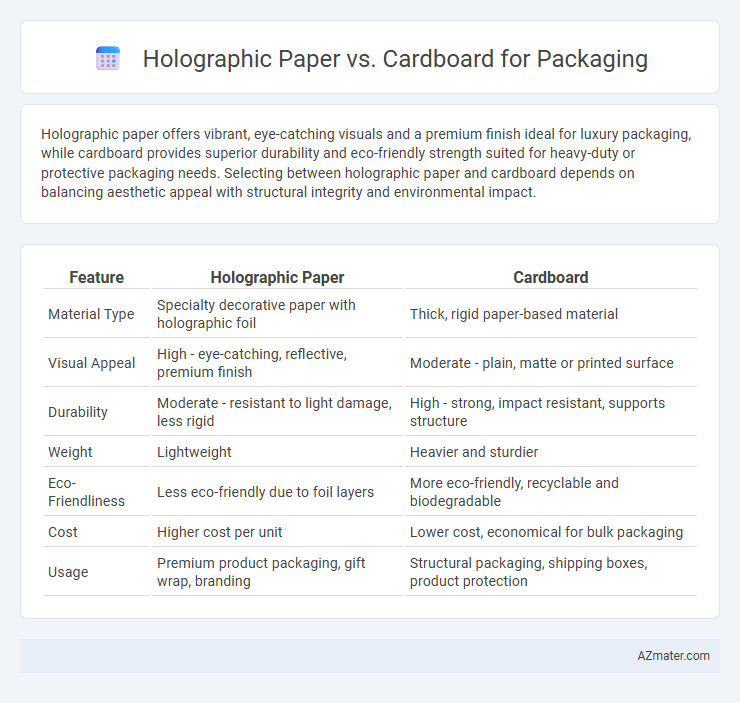Holographic paper offers vibrant, eye-catching visuals and a premium finish ideal for luxury packaging, while cardboard provides superior durability and eco-friendly strength suited for heavy-duty or protective packaging needs. Selecting between holographic paper and cardboard depends on balancing aesthetic appeal with structural integrity and environmental impact.
Table of Comparison
| Feature | Holographic Paper | Cardboard |
|---|---|---|
| Material Type | Specialty decorative paper with holographic foil | Thick, rigid paper-based material |
| Visual Appeal | High - eye-catching, reflective, premium finish | Moderate - plain, matte or printed surface |
| Durability | Moderate - resistant to light damage, less rigid | High - strong, impact resistant, supports structure |
| Weight | Lightweight | Heavier and sturdier |
| Eco-Friendliness | Less eco-friendly due to foil layers | More eco-friendly, recyclable and biodegradable |
| Cost | Higher cost per unit | Lower cost, economical for bulk packaging |
| Usage | Premium product packaging, gift wrap, branding | Structural packaging, shipping boxes, product protection |
Introduction to Holographic Paper and Cardboard Packaging
Holographic paper packaging features a reflective, multicolored surface achieved through micro-embossing techniques, enhancing visual appeal and brand differentiation in product presentation. Cardboard packaging, made from layered paper pulp, offers durability, recyclability, and structural support, commonly utilized for shipping and protective purposes. Both materials serve distinct roles, with holographic paper emphasizing aesthetic impact and cardboard focusing on strength and eco-friendly properties.
Material Composition: Holographic Paper vs Cardboard
Holographic paper consists of a thin layer of plastic film embossed with a diffraction pattern, adhered to paper to create a shiny, reflective surface, enhancing visual appeal and brand differentiation. In contrast, cardboard is made from multiple layers of cellulose fibers, typically corrugated for strength and durability, providing robust structural support for packaging. While holographic paper primarily serves as a decorative overlay, cardboard forms the foundational packaging material offering protection and rigidity.
Visual Appeal and Shelf Impact
Holographic paper offers vibrant, reflective surfaces that catch consumer attention with dynamic light effects, significantly enhancing visual appeal and shelf impact. Cardboard provides a sturdy and customizable canvas but lacks the eye-catching brilliance that holographic finishes deliver. Brands aiming for standout packaging often leverage holographic paper to boost product visibility and create a premium perception in retail environments.
Durability and Protective Qualities
Holographic paper offers a visually striking finish but lacks the durability and protective strength of cardboard, making it more suitable for lightweight packaging and decorative purposes. Cardboard provides superior structural integrity and impact resistance, ensuring better protection for fragile items during shipping and handling. For packaging requiring enhanced durability and cushioning, cardboard remains the preferred material over holographic paper.
Sustainability and Eco-Friendliness
Holographic paper often contains metallic layers and plastic coatings that hinder recyclability and increase environmental impact, while cardboard is widely recognized for its biodegradability and ease of recycling, making it a more sustainable packaging option. The production of cardboard typically involves renewable resources and less harmful chemicals compared to holographic paper, which relies on non-renewable materials and energy-intensive processes. Choosing cardboard over holographic paper reduces landfill waste and supports circular economy practices in packaging industries.
Cost Comparison: Holographic Paper vs Cardboard
Holographic paper packaging generally incurs higher costs due to its specialized materials and printing process, making it a premium option for branding and visual appeal. Cardboard packaging is more cost-effective, benefiting from widespread availability and simpler manufacturing methods, thus preferred for budget-conscious bulk shipments. Businesses must weigh the price difference against marketing impact when choosing between holographic paper and cardboard packaging.
Branding and Customization Opportunities
Holographic paper enhances branding by providing vibrant, reflective surfaces that attract consumer attention and create a premium, eye-catching look, ideal for luxury products. Cardboard offers extensive customization through various sizes, shapes, and printing techniques, allowing brands to convey their identity with eco-friendly and durable packaging solutions. Combining holographic elements with cardboard can maximize visual impact while maintaining structural integrity, offering versatile branding opportunities.
Printing and Design Flexibility
Holographic paper offers superior printing clarity and vibrant color reproduction, making it ideal for eye-catching packaging designs that demand high visual impact. Its glossy, reflective surface enhances intricate patterns and holographic effects, providing greater design flexibility compared to the matte finish of cardboard. Cardboard excels in durability and structural support but limits printing techniques to less detailed, flat designs, thus reducing options for complex, high-resolution graphics.
Consumer Perceptions and Market Trends
Holographic paper packaging attracts consumers with its eye-catching, reflective designs that convey premium quality and innovation, often influencing purchasing decisions in beauty and luxury goods markets. Cardboard packaging, favored for its eco-friendly appeal and recyclability, aligns with rising consumer demand for sustainable and biodegradable materials, particularly in food and retail sectors. Market trends reveal a growing preference for environmentally responsible packaging, yet holographic finishes remain popular for limited editions and gift packaging, highlighting a balance between sustainability and visual impact.
Choosing the Right Material for Your Packaging Needs
Holographic paper offers eye-catching, reflective surfaces that enhance brand visibility and attract consumer attention, making it ideal for premium product packaging and limited editions. Cardboard provides superior durability and protection, suitable for shipping and bulk packaging where structural integrity is crucial. Selecting between holographic paper and cardboard depends on balancing visual impact with functional requirements such as strength, cost-efficiency, and environmental considerations.

Infographic: Holographic paper vs Cardboard for Packaging
 azmater.com
azmater.com